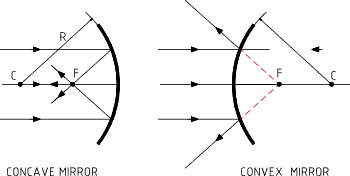Mirrors - Lenses
|
Mirrors & Lenses
Spherical Mirrors Spherical Mirrors can be either Concave or Convex. Concave mirror f = + R/2
Note: for the convex mirror the focal point is a virtual point located behind the surface of the mirror.  Mirror Equation For an object located a distance p from a mirror the image is located at a distance q from the mirror surface as difined below: 1 / p + 1 / q = 1 / f Therefore : p = q.f / ( q - f ) and q = p.f / ( p-f ) and f = p.q / ( p + q )
Magnification The linear magnification ( m ) of any optical system is the ratio between the size (height or width or other transverse dimension ) of image and the associated size of the relevant object. In the case of a mirror. m = h' / h = - q / p The magnification = Image Height/ Object Height = image distance / object distance.
A positive magnification indicates a image in the same direction as the object. A negative
image indicates a inverted image... Lenses These notes related only to simple thin lenses with neglible glass thickness...  The equation is used to calculate the focal length 1 / f = ( n - 1 ) . ( 1 / R1 + 1 / R2 )
n = the index of refraction of the lens material relative to the surrounding medium. The lens equation The object distance, the image distance and the focal length of a lens are related by the following formula. 1 / f = 1 /p + 1 / q Therefore p = q.f / (q -f) and q = p . f / ( p - f ) and f = p . q. / ( p + q ) Magnification... The same as for mirrors as indicated above ..The linear magnification ( m ) of any optical system is the ratio between the size (height or width or other transverse dimension ) of image and the associated size of the relevant object. In the case of a mirror. m = h' / h = - q / p The magnification = Image Height/ Object Height = image distance / object distance.
A positive magnification indicates a image in the same direction as the object. A negative
image indicates a inverted image... |
Sites & Links for physics of lens and mirrors
|
|